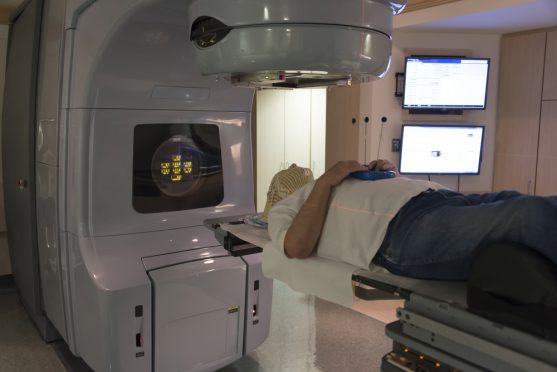The author of this post, Dr Rejil Rajan, is a Consultant Oncologist with Onco.com.
Radiation therapy is a treatment modality that delivers high energy electromagnetic waves or particles like gamma rays, X-rays, electrons or protons to kill cancer cells. Radiation therapy was first used to treat cancer over a century ago. Since then, huge progress has been made to improve the effectiveness of this modality and minimize side effects. It can be used alone or in combination with other treatment options for treating different cancers.
Radiation therapy involves the use of high-energy beams to damage cancer cells’ DNA, thereby, restricting their growth and division or causing direct damage. It may be delivered externally using linear accelerator machines or internally via radioactive sources placed inside or next to the area requiring treatment.

Side effects or toxicities of radiation therapy
Similar to any other cancer treatment, radiation therapy can damage healthy cells along with the cancer cells in and around the treatment area, and cause side effects.
The side effect will depend on the type and location of cancer, the dose of radiation being given, general health of the patient, effect of other cancer treatments, such as surgery and chemotherapy. Also, the severity of side effects may differ from patient to patient. Some may experience few or even no side effects from radiation therapy, while others may experience severe side effects.
The side effects of radiation therapy (RT) can be broadly divided into acute and late side effects. Acute side effects or toxicities develop during or shortly after the completion of treatment and are usually temporary. Late side effects or toxicities present months to years after the completion of treatment and are often permanent.
In this article we will discuss in brief the acute side effects of radiation therapy.
Skin toxicity (Radiation dermatitis)
Of those receiving radiation therapy, as many as 95% may experience some form of radiation dermatitis, or skin toxicity. The skin changes progress from dryness, itching, dark colouration to peeling off, which starts with peeling of dry skin (painless) which is called as dry desquamation and later progresses to exposing a deeper skin layer (dermis layer of skin) with serous discharge and is painful, which is called as wet desquamation. Very rarely, if further progresses, serious side effects like ulcer formation or bleeding may occur.
Skin reaction and time of onset:
| Skin reaction | Time of onset |
| Hyperpigmentation (darkening of skin), dry skin, itching | 1 to 2 week after starting RT |
| Dry desquamation | 3 to 4 week after starting RT |
| Wet desquamation | After 4 weeks of starting RT |
Grading
Grading is used to assess the severity of the toxicity. Clinicians usually use RTOG acute toxicity grading to assess the acute toxicities.
During a radiation therapy course, a weekly review is mostly carried out by your doctor to assess the grades of toxicity and depending on the grades or severity of toxicity, he may start symptomatic medicines to provide relief.
If the toxicity is severe, usually grade 3 and above, your doctor will pause radiation therapy for a period of time and will resume it once the toxicity settles down.
Here we will look into the grading.
| Grade | 0 | 1 | 2 | 3 | 4 |
| Changes | No change | Dry skin, darkening of skin, itching, dry desquamation, hair loss | Patchy moist desquamtion | Confluent Moist desquamation | Ulcer, bleeding |
Factors affecting the risk of radiation dermatitis:
Tumour related factors:
- If the tumour is close to skin, there is an increased risk of skin toxicity, for example- in case of head and neck cancers, anal cancer etc.
Treatment related factors:
- Energy of the radiation used; higher energy has more skin sparing property. For example, treatment using gamma rays from cobalt has less skin sparing resulting in more skin toxicity.
- Dose of radiation and schedule
- Concomitant use of chemotherapy which increases the toxicity
Patient related factors:
- Malnutrition
- Smoking
- Excessive skin folds
- Obesity
- Connective tissue diseases
Oral mucositis
Oral mucositis is the inflammation of oral mucosa, tongue, and pharynx after radiation therapy to head and neck cancers like buccal mucosa, tongue cancers etc. It has marked adverse effects on the patient’s quality of life. It occurs in up to 80% of head and neck cancer irradiated patients. Grade 3 and 4 have been recorded in 56% of head and neck cancer patients treated with radiotherapy.
Oral mucositis starts as redness which progresses to patchy small ulcers and which later coalesce to form a bigger ulcer with severe pain. Very rarely, if it further progresses, serious side effects like deep ulcer formation or bleeding may occur. As the severity of mucositis increases, pain and difficulty in swallowing also increases.
If the toxicity is severe, usually grade 3 and above, your doctor will pause radiation therapy for a period of time and will resume it once the toxicity settles down.
| Oral mucositis | Time of onset |
| Diffuse redness | 1 to 2 week after starting RT |
| Patchy small ulcers | 2 to 4 week after starting RT |
| Confluent ulcers | After 4 weeks of starting RT |
| Grade | 0 | 1 | 2 | 3 | 4 |
| Changes | No change | Diffuse redness | Patchy small ulcers, experience moderate pain requiring painkiller | Confluent ulcers,
experience severe pain requiring painkillers like morphine |
Deep ulcer, bleeding |
Factors leading to increased risk of oral mucositis
- Bad oral hygiene
- Concurrent use of chemotherapy
- Smoking
- Malnourished individuals
- Elderly age
Gastrointestinal toxicity
Gastrointestinal toxicity can occur following irradiation of thoracic, abdominal, or pelvic malignancies if gastrointestinal structures like esophagus, stomach, intestine etc are located within the radiation therapy field.
| Organ toxicity | Esophagus | Stomach | Intestine | Rectum | Anal canal |
| Factors affecting
toxicity |
Radiation dose, technique of radiation, concurrent use of chemotherapy (toxicity increases) | Radiation dose and
concurrent use of chemotherapy |
Dose and schedule of RT, concurrent use of chemotherapy. | Radiation dose, RT technique | RT technique,
concurrent use of chemotherapy |
| Symptoms | Difficulty in swallowing, painful swallowing (usually occur with 2-3 weeks of starting RT) | Nausea and vomiting, anorexia, abdominal pain, and malaise | Diarrhea (appears during the third week of treatment), abdominal pain, nausea and vomiting, anorexia (loss of appetite), and malaise | Diarrhea, mucus discharge, urgency, tenesmus (feeling of incomplete defecation), and, uncommonly, bleeding | Skin toxicity, pain, bleeding, and tenesmus |
Grading
| Grade | 0 | 1 | 2 | 3 | 4 |
| Esophagus | No change | Mild dysphagia (difficulty in swallowing) or odynophagia (painful swallowing),may require soft diet | Moderate dysphagia or odynophagia, may require pureed or liquid diet | Severe dysphagia or odynophagia with dehydration or weight loss > 15%, may require ryles tube feeding, IV fluids. | Complete obstruction, ulcer, perforation, fistula |
| Upper GI(stomach, intestine) | No change | Anorexia (loss of appetite) with less than or equal to 5 % weight loss,
mild nausea, vomiting and abdominal pain |
Anorexia with less than or equal to 15 % weight loss, moderate nausea and vomiting and abdominal pain | Anorexia with >15% weight loss or requiring ryles tube support, severe nausea, vomiting, abdominal pain | Obstruction, perforation, bleeding |
| Lower GI (rectum, sigmoid colon) | No change | Increased frequency or change in quality of bowel habits not requiring medication, rectal discomfort not requiring analgesics | Diarrhea requiring drugs like Lomotil, rectal or abdominal pain requiring painkillers | Severe diarrhea needing IV fluids, severe mucous or blood discharge | Obstruction, perforation, bleeding |
Genitourinary toxicity
Genitourinary toxicity can occur following irradiation of pelvic malignancies like prostate cancer, cervical cancer, endometrial cancer etc, if genitourinary structures like bladder, vagina etc are located within the radiation therapy field.
Bladder toxicity is a common genitourinary toxicity encountered which manifests as burning sensation while urinating, increase in frequency of urination, urgency, and nocturia. As the severity increases the frequency of urination and nocturia increases. Very rarely, in severe cases, bleeding can occur which presents as hematuria.
Factors affecting bladder toxicity include radiation dose and the technique of radiation. More conformal techniques like IMRT have shown to reduce the toxicity.
| Grade | 0 | 1 | 2 | 3 | 4 |
| Changes | No change | Frequency of urination or nocturia two times | Frequency increases: Day:12-16 times;
Nocturia 5-8 times |
Frequency increases: Day:>16 times;
Nocturia >8 times |
Hematuria requiring blood transfusion |
CNS (brain) toxicity
Radiation therapy to brain is used to treat patients with primary or metastatic brain tumors and also to reduce the risk of cancer cells spread to brain (prophylactic cranial irradiation). Factors affecting toxicity depend on the volume of normal brain tissue treated, the total radiation dose, fractionation schedule and use of concurrent or sequential chemotherapy. The symptoms include headache, nausea and vomiting, worsening of preexisting neurological symptoms may happen.
Salivary gland toxicity- Dryness of Mouth
These effects are due to irradiation of both the major (parotid, submandibular, sublingual) salivary glands and the minor salivary glands during treatment for head and neck cancers. Approximately 70% of patients receiving head and neck radiotherapy develop toxicity. Temporary decreased saliva production becomes evident within one to two weeks after the initiation of RT. The severity of the damage depends on the salivary function before treatment, the area of salivary tissue exposed, the total dose radiation and response of each individual. The symptoms include dryness of mouth or thick, sticky saliva and altered taste.
Lung toxicity
Acute lung toxicity is commonly associated with radiation therapy to lung cancer. Symptoms include dry cough, breathlessness on exertion and low grade fever. Symptoms usually develop approximately 4 to 12 weeks after completing radiation. This is called radiation pneumonitis.
Conclusion
Acute side effects or toxicities of radiation therapy are temporary which means the majority of these side effects fade away within a few weeks after completion of the treatment.
Managing the side effects associated with the radiation therapy is a crucial step. It is important for the patient to maintain a positive attitude during and after the treatment and this is very much possible under the constant guidance of your treating team.



